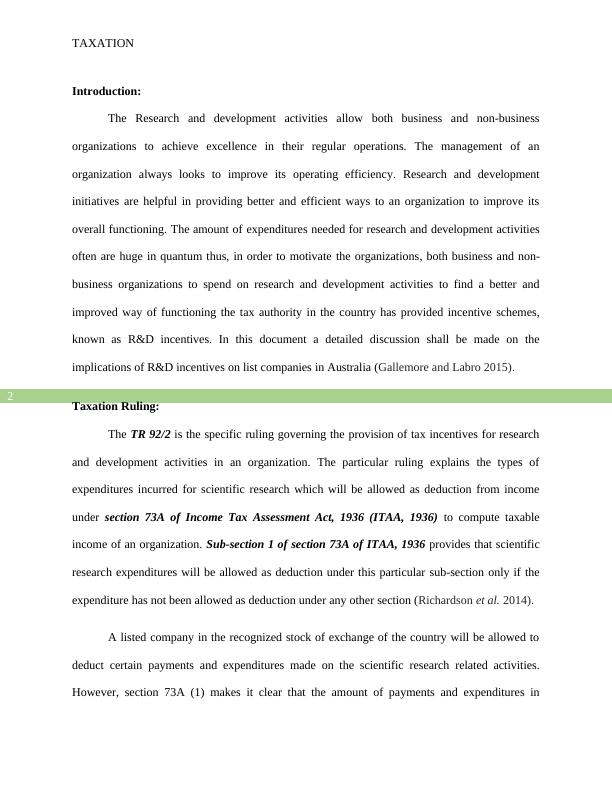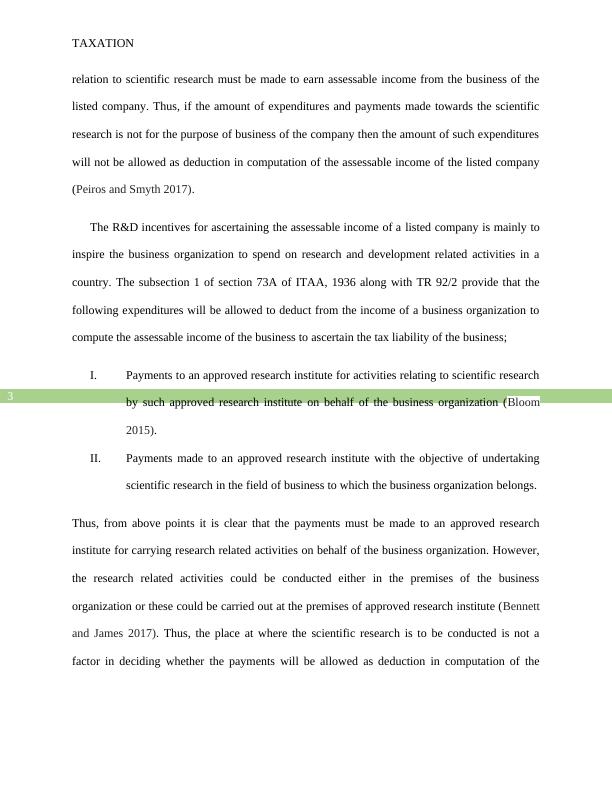Implications of R&D Incentives - Doc
Added on 2020-05-28
12 Pages2764 Words35 Views
Running head: TAXATIONTaxationName of the Student:Name of the University:Authors Note:

1TAXATIONTable of ContentsIntroduction:....................................................................................................................................2Taxation Ruling:..............................................................................................................................2Increased level of concentration on research and development activities:......................................6Leverage of tax position:.................................................................................................................7Increase in operating efficiency:......................................................................................................7The performances of listed entities have improved:........................................................................7Maintenance of proper records and documentation:.......................................................................8Adherence with the income tax provisions:.....................................................................................8Conclusion:......................................................................................................................................8References:....................................................................................................................................10

2TAXATIONIntroduction: The Research and development activities allow both business and non-businessorganizations to achieve excellence in their regular operations. The management of anorganization always looks to improve its operating efficiency. Research and developmentinitiatives are helpful in providing better and efficient ways to an organization to improve itsoverall functioning. The amount of expenditures needed for research and development activitiesoften are huge in quantum thus, in order to motivate the organizations, both business and non-business organizations to spend on research and development activities to find a better andimproved way of functioning the tax authority in the country has provided incentive schemes,known as R&D incentives. In this document a detailed discussion shall be made on theimplications of R&D incentives on list companies in Australia (Gallemore and Labro 2015).Taxation Ruling: The TR 92/2 is the specific ruling governing the provision of tax incentives for researchand development activities in an organization. The particular ruling explains the types ofexpenditures incurred for scientific research which will be allowed as deduction from incomeunder section 73A of Income Tax Assessment Act, 1936 (ITAA, 1936) to compute taxableincome of an organization. Sub-section 1 of section 73A of ITAA, 1936 provides that scientificresearch expenditures will be allowed as deduction under this particular sub-section only if theexpenditure has not been allowed as deduction under any other section (Richardson et al. 2014). A listed company in the recognized stock of exchange of the country will be allowed todeduct certain payments and expenditures made on the scientific research related activities.However, section 73A (1) makes it clear that the amount of payments and expenditures in

3TAXATIONrelation to scientific research must be made to earn assessable income from the business of thelisted company. Thus, if the amount of expenditures and payments made towards the scientificresearch is not for the purpose of business of the company then the amount of such expenditureswill not be allowed as deduction in computation of the assessable income of the listed company(Peiros and Smyth 2017). The R&D incentives for ascertaining the assessable income of a listed company is mainly toinspire the business organization to spend on research and development related activities in acountry. The subsection 1 of section 73A of ITAA, 1936 along with TR 92/2 provide that thefollowing expenditures will be allowed to deduct from the income of a business organization tocompute the assessable income of the business to ascertain the tax liability of the business; I.Payments to an approved research institute for activities relating to scientific researchby such approved research institute on behalf of the business organization (Bloom2015). II.Payments made to an approved research institute with the objective of undertakingscientific research in the field of business to which the business organization belongs.Thus, from above points it is clear that the payments must be made to an approved researchinstitute for carrying research related activities on behalf of the business organization. However,the research related activities could be conducted either in the premises of the businessorganization or these could be carried out at the premises of approved research institute (Bennettand James 2017). Thus, the place at where the scientific research is to be conducted is not afactor in deciding whether the payments will be allowed as deduction in computation of the

End of preview
Want to access all the pages? Upload your documents or become a member.
Related Documents
Taxation Law Assignment: Taxation Ruling 92/2lg...
|12
|2761
|68
Tax Incentives for Scientific Research and Development Activitieslg...
|10
|2374
|342
The Research and Development Tax Incentiveslg...
|10
|2766
|292
Professional Practice Taxationlg...
|9
|1393
|47
Assignment on Taxation Law (Doc)lg...
|11
|1671
|31
TAX305 – Taxation Law Assignmentlg...
|7
|530
|85
